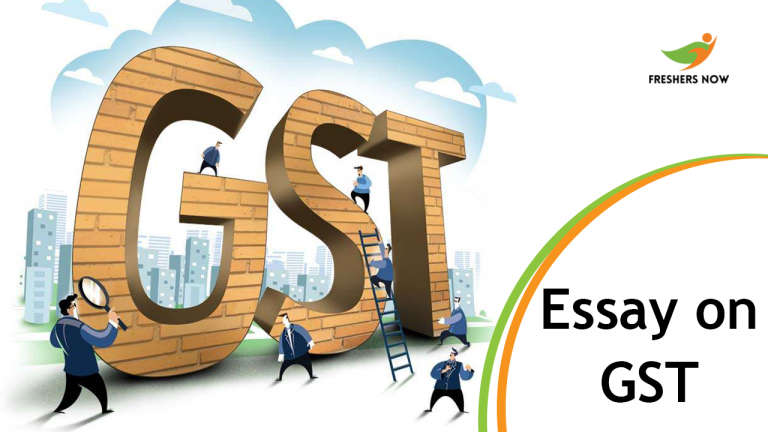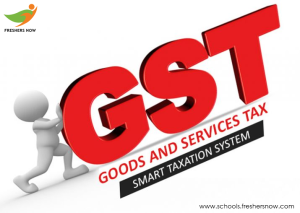
In this article, we are providing an essay on GST, The History of GST, Features of GST, GST in Detail, Commandment, Advantages & Disadvantages of GST, Images. Students can go through this page for more information on GST.
Contents
Essay On GST for Students and Children
It is referred to as the roundabout tax or the value-added tax levied on the freight and services sold for conjugal expenditure. GST is implemented tax in India. The tax is paid by the patrons, but it is abated by the government from the production selling the commodities and services.
The intention of Goods and Service Tax is to subsume the majority circuitous taxes like a value-added tax(VAT), Excise duty tax, Custom duty tax, entertainment tax, service tax, etc., which are customary in a single concept as One nation – One tax.
GST is the tax that initiates commencing the point of consumption, further the tax obligation is at each stride of manufacture, finally, the reimbursement is for all the factions in the assorted arena of production.
History of GST
GST – Goods and Service tax, was initially introduced in the year 1999 by the Government of India during the days when Atal Bihar Vajpayee was our Prime Minister.
Besides, The Prime Minister set up a board under the surveillance of Asim Dasgupta, the Finance Minister of West Bengal, to articulate a model on GST.
Because the Goods and Service tax could not be implemented. Awaiting, Recently it was executed by the National Democratic Alliance by the government on 1st July 2017, which was escorted by the Bhartiya Janata Party.
Features of GST
- Appropriate on Contribute plane
- Objective-based assessment
- Twofold GST
- GST rates to be reciprocally determined
- Compound Tariff
GST in Detail
Goods and Service tax is a solitary levy method. The central and the state government simultaneously inflict the tax. Infliction takes place by the commendation of a federal council.
GST is alienated into five diverse tax slabs. The tax assortment is conceded in the course of this allotment.
The tax slabs are 0%, 5%, 12%, 18% and 28%.
Whereas Gold bear a unique rate of 3%. Further, fuel products, intoxicating drinks, and electrical energy are not considered in the GST.
The precious stones clutch charge of 0.25%. GST is applied in all transactions. They refer to procure, trade, import, export, and charter.
Commandment of GST
GST has implied based on 5 laws, they are
- State GST law: This law is pertinent to the types of equipment surrounded by the state.
Levy anthology will be communal by the state. - Central GST law: CGST is imposed by the Central government. Levy anthology will be communal by the central.
- Union Territory law: Taxes that are levied on the supply of commodities and services by the central and the state governments are the two types of taxes, they are intrastate and interstate. The law is appropriate to all the seven union territories within India.
- Integrated GST law: The tax will be alienated among the central and the state
government. The tax is levied on the interstate and import supply of possessions and supplies. - Goods and Services Law: This law is the reimbursement for states that may have faced any loss in reprisal due to GST implementation.
Advantages of GST
- Eradicate cascading tax effect.
- Composition Scheme for the infinitesimal industry.
- Uncomplicated and trouble-free online system.
- Configuration of the common national market.
- Intelligibility
- Superior restriction towards registration.
- Alleviate of carrying on a business.
- Diminish the number of compliances.
- Impede Corruption and Tax outflow.
- Inventive administration by the government.
Disadvantages of GST
- Industrialized states are unable to find income on a superior level.
- Elevated profits unbiased rate.
- SCGT and CGST key credit cannot be consumed.
- The charge of supplementary.
- The lessening in the financial independence of states.
- The triumph of GST depends on political compromise, technology, and the ability of tax officials to adapt to the innovative requirements.
Essay on GST: Images
Conclusion: We all should have the responsibility for the changes made in the country. GST is an affirmative stride towards changing the Indian financial system from an unofficial way to an official economy.
Essay on GST for Students and Children | PDF Download
Dear Students and Children, you can download the GST Essay in the Hand Written Format by Clicking the Below Click Here Link.
| GST Essay- Important Link | |
| To download the GST Essay PDF | Click Here |


